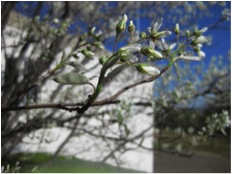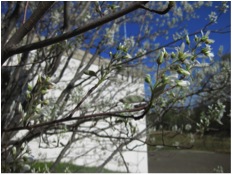Amelanchier
Contact
Katharine Ordway Natural History Study Area9550 Inver Grove Trail Inver Grove Heights, MN 55076 651-455-6204 (On Site)
651-696-6230 (On Campus)
andersonm@macalester.edu
Biotic Inventory: Documenting Diversity at the Katharine Ordway Natural History Study Area
Amelanchie, Amelanchier laevis? or Amelanchier arborea?


Taxonomy
Kingdom: Plantae
Phylum: Magnoliophyta / Angiospermae
Class: Magnoliopsida
Order: Rosales
Family: Rosaceae
Subfamily: Maloideae / Spiraeoideae
Genus: Amelanchier
Species: laevis, arborea
Common name:
laevis – Apple Severiceberry, Smooth Serviceberry, Juneberry
arborea – Downy Serviceberry, shadbush
Diagnostic Characteristics
This species belongs to the genus Amelanchier. The main characteristic that identifies this species within this genus is the presence of white flowers with five petals. Other characteristics that support the identification of this species include leaves with saw-like edges and the small, shrub size of the whole tree. Lastly, Amelanchier is a genus native to the North Temperate zone, which is where this species is found.
This species sample was collected during the early spring when the tree just starts to bud young flowers. As a result, the foliages and flowers are not in their adult stages. This limits the identification of this species as most of the Amelanchier in their young stage look really similar. However, when comparing the morphology of the young foliages with the Amelanchier database, this species is likely to be either Amelanchier laevis or Amelanchier arborea.
According to Carl Otto Rosendahl’s method of identifying Amelanchier, Amelanchier laevis and Amelanchier arborea have a very similar morphology as they share almost exactly the same characters:
“Flowers racemose, leaves rounded or subcordate at the base, conduplicate in the bud, summit of ovary rounded…Leaves serrate-dentate to finely serrate, at least in the upper third, principal veins running branched or unbranched into the teeth… Leaves finely toothed or serrate, main lateral veins not prominent, somewhat irregularly and unequally spaced, usually with shorter intermediate ones… Tall shrubs or small tree, not stoloniferous or forming colonies (sometimes fastigate), leaves ovate, elliptic-ovate to slightly obovate or elliptic to oblong, apex acute to more or less acuminate or apiculate… Top of the ovary is glabrous1.”
The difference that separates A. laevis and A. arborea is the morphology of their leaves. A. laevis leaves are densely covered with tiny hairs. When flowering time arrives, the leaves become small and folded. When mature, the foliage is pointy and ovate; the petiole and the lower surface are also both covered with tiny hairs.
On the other hand, A. arborea leaves are devoid of hair, or have very few hairs, during the unfolding time. The structure, however, is similar to A. laevis. The structure of leaves when mature is also similar to A. laevis, except that these have fewer, or even no, hair1,3.
It is difficult to specify whether the collected sample belongs to the species A. laevis or A. arborea as the tree is still young, and therefore so are the leaves. The hair on the surface of the leaves is present in a few amounts, but this could be attributed to the fact that the tree is still growing. When the leaves mature, it may or may not be covered with hair in high density. The fully grown tree may be 25 feet or 50 feet, in which observations over a longer period of time would be needed in order to determine the species of this collected sample.
Ecology
A. arborea
A. arborea grows in a variety of habitats such as swampy lowlands, dry woods, sandy bluffs, rocky ridges, forest edges, open woodlands and fields4 but it mostly grows in rich woods, thickets, and on hillsides. It is a small tree or multi-stemmed large shrub with small arching, spreading branches. The tree can grow up to 50 feet high, but it is short-lived. The leaves resemble those of apple trees, their close relative. The leaves are simple with the length of 1-3 inches long. The colors of the leaves (when newly born) are purple/dark green in the summer, and vary from yellow to red in the fall. The flowers bloom in clusters with five petals of white flowers in early spring, but only for a few days, then the color will change to rosy pink. They are 2-4 inches in length. The fruits are small and fleshy with seed chambers, which ripen in June. The color of the berry-like fruit turns from green to purplish black. When this happens, the fruit is eaten and dispersed by animals in the wild. The fruit is also a food source for the larvae of tiger butterflies, gypsy moths and viceroys; furthermore, they are the best source of food for birds during the summer. The bark A. arborea is smooth and gray, but often with a reddish cast. As the bark ages, it becomes ridged and scaly3.
A. laevis
A. laevis is a deciduous, multi-stemmed large shrub or small tree with many small branches. The tree grows up to 25 feet high. It has a rapid growth rate but is short-lived. The leaves are simple, 1-3 inches in length. The color of the leaves during flowering time is bronze/purple, but varies from yellow to red during the fall1,2. The white flowers are in four-inch long clusters; the flowers also have five petals. The sweet fruit are 3/8 of an inch in length, with a rich purple-black color when it matures. They are also eaten and dispersed by wildlife, especially birds. The bark of A. laevis is reddish brown when young, but turns dull grayish when older2.
Life History
A. arborea
The growth rate of this species is medium: 9 to 10 feet in a 5 to 8 year period. This species reproduces mainly by seed, in which birds and mammals are the medium of dispersal; the birds play a major role in germination as they scarify the seeds after ingestion. This species also sprouts from the roots. The seeds will not germinate until after the second spring. This species is prone to rusts, blights, powdery mildew, leaf minors, leaf spot, borers and scale3,4.
A. laevis
The growth rate of this species is rapid. This species reproduces through dispersion of seeds. The flowers of this species are fragrant, and so attracted animals for pollination. The vectors for pollination are birds, butterflies and insects. This species is also prone to rusts, blights, powdery mildew, leaf minors, leaf spot, borers and scale2,4
Both A. laevis and A. arborea are short-lived, as previously mentioned.
Distribution
A. arborea
This species is native to eastern North America. It is commonly found distributed from northern Florida to Louisiana and Oklahoma, and northward to Maine, New Brunswick, southwestern Quebec, southern Ontario, northern Michigan, west to Alabama, southern Mississippi, Louisiana, Texas (rare), Oklahoma, Kansas, Nebraska, Minnesota, and the dry woodlands slopes and plateaus of Kentucky1,3,4.
A. laevis
This species is common throughout deciduous forests, on the edges of woods and in ravines with moist hillsides. It is found less frequently northeastward in the coniferous forest native from Newfoundland to Georgia, Kentucky, Alabama, Minnesota, west to Michigan, south to Pennsylvania and Kansas1,2.
Voucher Information
This species was collected near the parking of the Katherine Ordway Natural History Study Area in Inver Grove Heights, Minnesota. The sample was chosen from the tree located on slightly sloping ground.
References
1. Rosendahl, C. O.,. (1955). Trees and shrubs of the upper midwest. Minneapolis: University of Minnesota Press.
2. Bernheim: Arboretum and Research Forest. 2010. http://www.bernheim.org/amelanchier_laevis.html
3. Bernheim: Arboretum and Research Forest. 2010. http://www.bernheim.org/amelanchier_arborea.html
4. United States Department of Agriculture: Natural Resources Conservation Service. 2010. http://plants.usda.gov/plantguide/pdf/pg_amar3.pdf
5. Evergreen: Native Plant Database. 2010. http://nativeplants.evergreen.ca/search/view-plant.php?ID=00054
Compiled by Cynthia Amelanchier.
Biodiversity & Evolution (BIOL 270) Professr Sarah Boyer. Spring 2010.
Specimen collected at Macalester College’s Katharine Ordway Natural History Study Area on April 15, 2010.